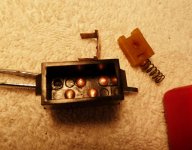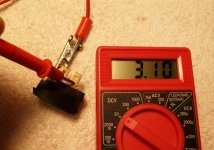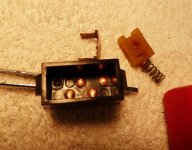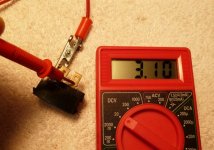Any electrical engineers out there. . .?
I'm generally pretty handy with electrical repairs - you pretty much have to be with several British cars but this one has me stumped.
Item: Spring loaded rocker switch that will make a circuit only when pressed then snap back to off - used on a Jensen Interceptor to activate a solenoid which opens the fuel filler flap. It had begin to only work occasionally.
Diagnosis: Removed switch, hooked up 12v power supply and tested - sometimes switched full 12v, sometimes only switched something like .8v. Figured it was grungy inside so I carefully disassembled switch and cleaned all the contacts with metal cleaner - See photo 1 - and reassembled.
Problem: Now, 3.1 volts bleeds through the switch even when in the "off" position. Disassembled again and took the guts out to make sure I hadn't put it back together incorrectly. The two spade terminals are not connected in any way, yet 12v supplied to one terminal will feed 3.1v to the other terminal. See photo 2.
I've done all my own Lucas electrical work for 40 years and I do not understand what is happening here?
Any opinions?
Photo 1

Photo 2 - how can this be when these are not connected in any way?

Thanks,
Bob
'73 Jensen Interceptor
various others
I'm generally pretty handy with electrical repairs - you pretty much have to be with several British cars but this one has me stumped.
Item: Spring loaded rocker switch that will make a circuit only when pressed then snap back to off - used on a Jensen Interceptor to activate a solenoid which opens the fuel filler flap. It had begin to only work occasionally.
Diagnosis: Removed switch, hooked up 12v power supply and tested - sometimes switched full 12v, sometimes only switched something like .8v. Figured it was grungy inside so I carefully disassembled switch and cleaned all the contacts with metal cleaner - See photo 1 - and reassembled.
Problem: Now, 3.1 volts bleeds through the switch even when in the "off" position. Disassembled again and took the guts out to make sure I hadn't put it back together incorrectly. The two spade terminals are not connected in any way, yet 12v supplied to one terminal will feed 3.1v to the other terminal. See photo 2.
I've done all my own Lucas electrical work for 40 years and I do not understand what is happening here?
Any opinions?
Photo 1

Photo 2 - how can this be when these are not connected in any way?

Thanks,
Bob
'73 Jensen Interceptor
various others

 Hi Guest!
Hi Guest!

 smilie in place of the real @
smilie in place of the real @
 Pretty Please - add it to our Events forum(s) and add to the calendar! >>
Pretty Please - add it to our Events forum(s) and add to the calendar! >> 


